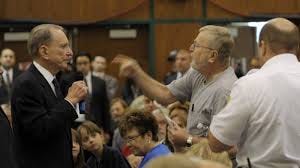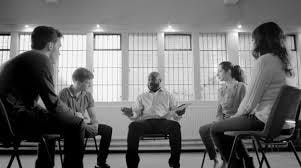A week ago I titled this essay and then had to put it on ice until now. Then some pivotal events took place that have reinforced my interest in civility.
In three different email exchanges with local government leaders, I learned that people in public administration are leaving their jobs due to the anger, rudeness and “incivility” of the local citizenry.
I attended my son’s college graduation after the university leadership supported the pepper-spraying, arresting and dismissal of hundreds of student and faculty protestors.
My inbox blew up with posts from a local neighborhood forum about a few dogs spotted off-leash in a “no dogs allowed” park in town.

We have a tendency to measure outrage in proportion to the severity of the circumstances, but I think that misses the point. The people who posted anti or pro “dog rules” were genuinely upset and used the best outlet at their disposal. The same was the case with the state and university leaders. They used what they had, which included the police force. All parties are angry. All parties have a sense of the “them” that is the problem. And all parties use what they have to enact what they believe is an appropriate response.
That tends to be the order of things:
I am angry about something (injustice, harm, privilege.)
I identify the person or force that is the cause of the problem (protestors, rule-breakers, leaders, police.)
I do something in response to that person or force (demonstrate, barricade, use force, make a statement.)
It seems like a fair assessment and it is often the way conflict is measured. We identify the source of discontent, we list the actions and reactions, and then—hopefully—explore ways we can find a peaceful solution.
It seems to me, however, that we don’t get very far, because we generally don’t acknowledge a foundational part player in this dynamic: storytelling. The violence, the outrage, and the demands for change all stem from stories. As I have said many times in the past, “stories” does not mean “untrue”. For me, stories are the very building block of reality. For instance, these statements are built of assumptions:
Rules should not be broken.
Civilians should not be killed.
People should be not be rude.
Leaders should not be oppressive.
These assumptions are, of course, based on stories. Each of these statements can be examined situationally and depending on the stories told within a particular community, exceptions are made.
Rules should be broken when saving someone’s life.
Civilians should be killed if those civilians are about to kill you.
People should be rude if they are defending the oppressed.
Leaders should be oppressive if it is needed to avoid total chaos and restore order.
What “should” or “shouldn’t” happen is always a story. There are always exceptions because our circumstances, identities, lived experiences, and genetics are all different. Everyone is their own rabbit hole.

So then, what is the point of this essay—that people should be allowed to be harmed because their stories make it justifiable? No that is not the point of this essay.
My point is that we have the capacity to empathize with what others believe is “civil,” and this empathy will change the way we respond.
When we can access genuine empathy (distinct from understanding, support or tolerance) for someone who disgusts or offends or even irritates us, our actions will be profoundly different than when we cannot.
If we have true empathy for our local leaders (town clerk, city manager, county commissioner) we are far more likely to make our case without using harmful language.
If we have true empathy for a protestor (again, distinct from agreement with their position) we are far more likely not resort to violence. The same is in reverse. If we are a protestor and have empathy for the governor or chief of police, we will not call them cruel names or throw things. We just won’t. In my experience, we can’t have empathy and want to harm someone.
Let me be clear: protests must happen and change must be demanded. Conversely, order must be restored so that democracy can be preserved. Rules must be followed while better rules must be explored. People need to be angry and express that anger AND we can do all these things with empathy.

Restorying is a real way to access empathy. Here’s how it works:
First you interrogate your own stories.
What do you believe is true? Include everything as it pertains to the subject at hand. Recognize that “killing children is wrong” is one of your stories. Again, I am not saying that a story is something made up or fantastic. I believe that stories actually make up one’s reality. So this is why I encourage taking a full inventory of the stories you believe are true. Assume nothing as universally true. Make it a long list.
Next use your imagination and curiosity to explore their stories.
Try to put your judgments on hold and be genuinely curious. Explore their situation and history. Explore the context in which they are acting. Imagine they have parents and grandparents who have a specific lived experience. What are the stories they have been steeped in? What assumptions do they have about reality? You are not gathering these stories to prove them wrong, you are exploring what they know to be “true.”
Finally—and this is the whole point—look for a connection.
What do you have in common with them? You might be on either side of a world conflict, but do you both love the same restaurant? Did you both lose a grandparent recently? Are you both wearing the same sneakers? Did you both notice the same misspelled poster at the same time and smile?
Connection makes your vulnerable. And vulnerability is where you will find empathy.
And so—what is the point of empathy, vulnerability and connection when you are trying to make the world a more just or compassionate place? How do these things help you when you are dealing with violent governments or assholes who are yelling at you?
Connection, vulnerability and empathy bring transformation.
They just do. As a storyteller, I make it the #1 priority to create connection, be vulnerable and access empathy because that is how I change a room. That is the only way I do it. Not through content or charisma, but through authentic connection. Its the only way. My attractiveness of my presence and the richness of my content is second to the connection I make with my listener.
So how do I “restory” civility?
I prioritize the connection first, and then the dialogue. Connection first, and then start to solve problems. Connection first, and then I protest or debate or discuss. Because once I discover the connection and make myself vulnerable, I gain empathy and ultimately …
trust.
And that is what we all want.
To trust the people around us. To trust them as doing the best they can with what they have. To trust that they are just as “right” as we are, and the only way I’ll get them to listen is to listen first.
Civility, therefore, is the enjoyment of trust, brought by empathy, brought by vulnerability, brought by connection, brought by listening.
Listening is the seed of it all.





Amazing piece here!